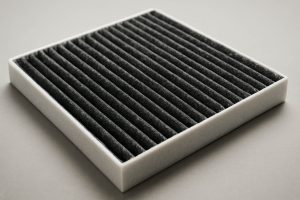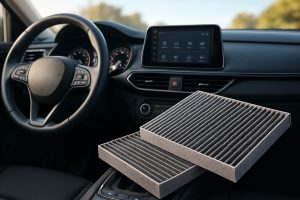When it comes to vehicle air quality and cabin comfort, most drivers think only about air conditioning or ventilation systems. However, one of the most critical yet often overlooked components is the activated carbon filter. Unlike standard cabin air filters that simply trap dust and debris, activated carbon filters go a step further — they adsorb harmful gases, odors, and volatile organic compounds (VOCs), significantly improving the air quality inside your vehicle.
In this article, we’ll explore the science behind how activated carbon works, why it’s used in modern automotive filters, the benefits it offers, and how to maintain it for peak performance.
What Is an Activated Carbon Filter?

An activated carbon filter is a type of cabin air filter enhanced with a layer of activated carbon (also known as activated charcoal) — a highly porous material with a massive surface area capable of trapping and neutralizing gaseous pollutants.
Unlike standard filters that rely purely on mechanical filtration (capturing particles), activated carbon filters also use adsorption — a chemical-physical process where gas molecules bond to the carbon’s surface.
How Activated Carbon Works: The Science
The effectiveness of activated carbon comes from its microstructure. Through a process of high-temperature heating and activation, raw carbon (often derived from coconut shells, coal, or wood) develops an incredibly large network of microscopic pores.
-
Surface Area: Just 1 gram of activated carbon can have a surface area of 800–1500 m², giving it extraordinary adsorption capacity.
-
Adsorption: Gas molecules like nitrogen dioxide (NO₂), sulfur dioxide (SO₂), benzene, or ozone adhere to the porous surface through Van der Waals forces and chemical bonding.
This makes activated carbon ideal for trapping:
-
Harmful gases from exhaust and traffic pollution
-
Volatile organic compounds (VOCs) from industrial emissions
-
Odors from fuel, smoke, or external environments
Key Components of an Activated Carbon Cabin Filter
| Component | Function |
|---|---|
| Non-woven fabric layer | Traps large particles like dust, pollen, and debris |
| Activated carbon layer | Adsorbs gases, odors, and harmful chemicals |
| Support layer | Provides structural strength and ensures airflow consistency |
Benefits of Activated Carbon Filters
Here are the main advantages of using an activated carbon filter compared to a standard cabin air filter:
-
Improved Air Quality – Removes not only dust and pollen but also gases, exhaust fumes, and VOCs.
-
Odor Neutralization – Eliminates unpleasant smells from the environment or engine bay.
-
Health Protection – Reduces exposure to harmful chemicals, benefiting passengers with allergies or respiratory conditions.
-
Enhanced Comfort – Keeps the cabin environment fresh, especially in heavy traffic or polluted urban areas.
Common Pollutants Captured by Activated Carbon Filters
| Pollutant | Source | Health Impact |
|---|---|---|
| NO₂ | Vehicle exhaust | Respiratory irritation, lung damage |
| SO₂ | Diesel engines, industrial zones | Breathing problems, eye irritation |
| Benzene | Fuel evaporation, exhaust | Carcinogenic effects |
| Ozone (O₃) | Urban smog | Chest pain, coughing, asthma worsening |
| VOCs | Industrial pollution, paint, fuel | Headaches, nausea, long-term toxicity |
Signs Your Activated Carbon Filter Needs Replacing
Like all filters, activated carbon filters lose effectiveness over time as their pores fill up with particles and gases.
Here are signs it’s time for a replacement:
-
Persistent cabin odors even with the ventilation system running
-
Reduced airflow through the vents
-
Increased allergy symptoms or respiratory irritation
-
Mileage exceeds manufacturer’s recommendation (usually every 15,000–20,000 km or once a year)
Tips for Maximizing Filter Efficiency
To get the most out of your activated carbon filter:
-
Replace it regularly – Follow the manufacturer’s maintenance schedule.
-
Avoid recirculating polluted air – Use fresh air mode in heavy traffic.
-
Check seals and housing – Ensure no air bypasses the filter.
-
Keep vents clean – Dust and debris buildup can reduce airflow.
Activated Carbon Filters vs. Standard Cabin Air Filters
| Feature | Standard Filter | Activated Carbon Filter |
|---|---|---|
| Particle filtration | Dust, pollen | Dust, pollen |
| Gas adsorption | None | NO₂, SO₂, VOCs |
| Odor removal | Limited | Excellent |
| Health benefits | Basic protection | Enhanced protection |
| Cost | Lower | Slightly higher |
Why Activated Carbon Filters Are a Must-Have in Modern Cars

With growing urban pollution, more vehicles on the road, and increased concerns about air quality, activated carbon filters have become standard in premium and mid-range cars — and for good reason. They’re not just about comfort; they’re about health and safety.
Breathing cleaner air can significantly reduce long-term health risks, improve driving focus, and make every trip more enjoyable — especially in cities where pollution levels can be many times above safe limits.
Final Thoughts
Activated carbon filters represent a perfect blend of simple chemistry and powerful performance. Their ability to trap harmful gases, neutralize odors, and improve cabin air quality makes them an essential upgrade for any modern vehicle.
If you’re considering replacing your old filter or upgrading to a high-efficiency solution, now is the perfect time to explore options and buy Filters online for your vehicle. Clean air isn’t just a luxury — it’s a necessity for both your health and your car’s interior environment.
In summary: Activated carbon filters may look simple, but the science behind them is sophisticated and effective. By understanding how they work and maintaining them properly, you can enjoy a cleaner, healthier, and more comfortable driving experience every day.